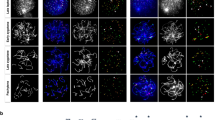Abstract
Pachytene oocytes from foetal mice heterozygous for the translocation T(14; 15)6Ca were screened for evidence of a “production-line” effect on chromosome pairing. Metaphase I oocytes from adult heterozygotes were also examined to determine whether any such effect on pahytene chromosome pairing is subsequently repeated during adult reproductive life as anticipated by the production-line hypothesis. It was found that as gestation proceeded the proportion of pachytene oocytes with a translocation quadrivalent declined and that with a trivalent and univalent correspondingly increased. That is, there was evidence of variation in pairing behaviour of the translocation at different times of gestation. In contrast, the proportions of metaphase I cells with either a quadrivalent or a trivalent plus univalent did not vary between adult females of different ages. Thus if the variation observed at pachytene was the result of a production-line effect, clearly this was not reflected in the behaviour of the translocation at metaphase I. Our observations therefore do not support the production line hypothesis for the maternal age effect on nondisjunction.
Similar content being viewed by others
References
Ashley T (1988) G-banded position effects on meiotic synapsis and crossing over. Genetics 118:307–317
Bond DJ, Chandley AC (1983) Aneuploidy. Oxford University Press, Oxford
Burgoyne PS, Baker TG (1984) Meiotic pairing and gametogenic failure. In: Evans CW, Dickinson HG (eds) Controlling events in meiosis. Company of Biologists, Cambridge pp 349–362
Dietrich AJJ (1986) The influence of hypotonic treatment on the morphology of meiotic stages. II. Prophase of the first meiotic of female mice up to dictyotene. Genetica 70:161–165
Eichenlaub-Ritter U, Chandley AC, Gosden RG (1988) The CBA mouse as a model for age-related aneuploidy in man: studies of oocyte maturation, spindle formation and chromosome alignment during meiosis. Chromosoma 96:220–226
Eicher EM, Washburn (1977) Mouse Newsl 56:43
Felluga B, Martinucci GB (1976) A simple method for karyotyping by transmission electron microscopy. J Submicrosc Cytol 8:347–352
Henderson SA, Edwards RG (1968) Chiasma frequency and maternal age in mammals. Nature 218:22–28
Hummler E, Theuring F, Hansmann I (1987) Meiotic nondisjunction in oocytes from aged Djungarian hamsters correlates with an alteration in meiosis rate but not in univalent formation. Hum Genet 76:357–364
Kaufman MH (1976) The incidence of chromosomally unbalanced gametes in T(14; 15)6Ca heterozygote mice. Genet Res 27:77–84
Luthardt FW, Palmer CG, Yu P-L (1973) Chiasma and univalent frequencies in aging female mice. Cytogenet Cell Genet 12:68–79
Moses MJ, Poorman PA (1981) Synaptonemal complex analysis of mouse chromosomal rearrangements. II. Synaptic adjustment in a tandem duplication. Chromosoma 81:519–535
Moses MJ, Poorman PA, Roderick TH, Davisson MT (1982) Synaptonemal complex analysis of mouse chromosomal rearrangements. IV. Synapsis and synaptic adjustment in two paracentric inversions. Chromosoma 84:457–474
Polani PE, Jagiello GM (1976) Chiasmata, meiotic univalents, and age in relation to aneuploid imbalance in mice. Cytogenet Cell Genet 16:505–529
Setterfield LA, Mahadevaiah S, Mittwoch U (1988) Chromosome pairing and germ cell loss in male and female mice carrying a reciprocal translocation. J Reprod Fertil 82:369–379
Speed RM (1977) The effects of ageing on the meiotic chromosomes of male and female mice. Chromosoma 64:241–254
Speed RM (1982) Meiosis in the foetal mouse ovary. I. An analysis at the light microscope level using surface-spreading. Chromosoma 85:427–437
Speed RM (1986) Oocyte development in XO foetuses of man and mouse: the possible role of heterologous X-chromosome pairing in germ cell survival. Chromosoma 94:115–124
Speed RM (1988) The possible role of meiotic pairing anomalies in the atresia of human fetal oocytes. Hum Genet 78:260–266
Speed RM, Chandley AC (1983) Meiosis in the foetal mouse ovary. II. Oocyte development and age-related aneuploidy. Does a production line exist? Chromosoma 88:184–189
Sugawara S, Mikamo K (1983) Absence of correlation between univalent formation and meiotic nondisjunction in aged female Chinese hamsters. Cytogenet Cell Genet 35:34–40
Sugawara S, Mikamo K (1986) Maternal ageing and nondisjunction: a comparative study of two chromosomal techniques on the formation of univalents in the first meiotic metaphase oocytes of the mouse. Chromosoma 93:321–325
Tarkowski AK (1966) An air-drying method for chromosome preparation from mouse eggs. Cytogenetics 5:394–400
Tease C, Fisher G (1986a) Further investigation of the productionline hypothesis in mouse foetal oocytes. I. Inversion heterozygotes. Chromosoma 93:447–452
Tease C, Fisher G (1986b) Oocyte from young and old female mice respond differently to colchicine. Mutat Res 173:31–34
Author information
Authors and Affiliations
Rights and permissions
About this article
Cite this article
Tease, C., Fisher, G. Further examination of the production-line hypothesis in mouse foetal oocytes. Chromosoma 97, 315–320 (1989). https://doi.org/10.1007/BF00371972
Received:
Issue Date:
DOI: https://doi.org/10.1007/BF00371972




